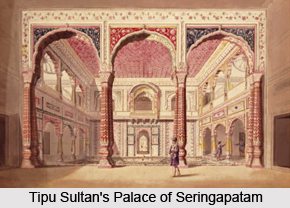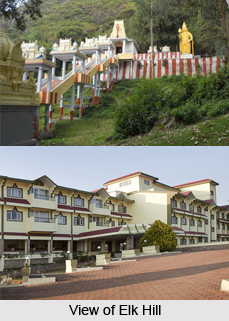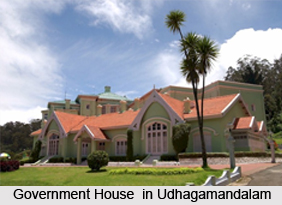 Most of the monuments of Udhagamandalam or Ooty are typically English in architectural style and purpose of construction. It is a popular hill station located in Tamil Nadu. It lies in the Nilgiri Hills at a height of 7,440 feet. John Sullivan, the local collector, built the first house in Ooty in 1823.It went on to become the summer headquarters of the Government from 1861 onwards. The arrival of the miniature railway from Mettupalayam in the late 19th century improved access from Chennai enormously and Ooty rapidly became a popular sanatorium and retreat for invalids.
Most of the monuments of Udhagamandalam or Ooty are typically English in architectural style and purpose of construction. It is a popular hill station located in Tamil Nadu. It lies in the Nilgiri Hills at a height of 7,440 feet. John Sullivan, the local collector, built the first house in Ooty in 1823.It went on to become the summer headquarters of the Government from 1861 onwards. The arrival of the miniature railway from Mettupalayam in the late 19th century improved access from Chennai enormously and Ooty rapidly became a popular sanatorium and retreat for invalids.
The town is spread around a large artificial lake and entirely surrounded by hills. To the east is the highest, Dodabetta; to the south-east is Elk Hill; to the south of the lake is Chinna Dodabetta; in the west are Cairn Hill and St Stephen`s Church Hill and to the north lie Snowdon and Club Hill. Since it was discovered and mostly inhabited by the Colonial Englishmen, most of the construction is also English in make. The houses are reached by narrow, winding English lanes bordered by imported English shrubs and flowers, and plantations of eucalyptus.
Religious Monuments in Udhagamandalam or Ooty
The St Stephen`s Church was built in 1830.It was designed by Captain John James Underwood and consecrated by the Bishop of Calcutta. The Church is built in Gothic style and has a low tower and crenellated parapets in cream stucco. The teak timbers were taken from Tipu Sultan`s Palace at Seringapatnam (Lai Bagli) and reused in the construction of the church. The columns inside are actually teak, but they have been plastered to resemble stone. There is a large protruding porte-cochere. Later additions were made in the form of the pews, 1842, and the clock bell, 1851.Some interesting brasses and memorial tablets are also to be found inside. Behind the Church is a cemetery, crowded with tombs, which are spread back up the hill in great profusion.
 Regency Gothick Union Church (1896) is passed; stylistically, it is sixty years out of date.
Regency Gothick Union Church (1896) is passed; stylistically, it is sixty years out of date.
Historical Monuments in Udhagamandalam or Ooty
The first house built in Ooty by John Sullivan in 1823, Stonehouse, is still existent here although in a much altered form. There is a lovely garden here full of beautiful herbs of a remarkable size. The house is now embedded in a building used by the Government Arts College.
Other houses of note are The Cedars, used by the Resident at Hyderabad, Crewe Hall (1830-31), Lushington Hall (1827-8) and Elk Hill House, built by George Norton for his own use in 1836.
A red brick range with corrugated iron roofs contains the Law Courts. It was built in 1873 in eccentric Gothic style and is also fitted with a needle top and spire. Though it was originally built as Breek`s memorial school, it became the Civil Court in 1899.
Close to it is the Nilgiri library. It was designed by Robert Fellows Chisolm in 1855.It has a lofty Reading room lit by the light streami8ng in through five arched windows. There is also a tall Gothic window at the far end. The fa‡ade is made of red bricks with stucco dressings.
The club is a long, low, single-storey range building with a pedimented Ionic centerpiece. It was built in 1831 as a hotel for the financier Sir William Rumbold under the supervision of his butler, Felix Joachim, who later went on to run the hotel. In 1843 the house was taken over by the Club. The interior is a perfect memorial to the days of the Raj, with animal trophies, tiger skins, old military and hunting prints and club furniture, all maintained beautifully. In 1875 Lieutenant Neville Chamberlain perfected the game of snooker here.
 Government House (1880) in Udhagamandalam is approached through the Botanical Gardens, which lie at the foot of Dodabetta Hills in a remarkable array of fascinating species of flora. A half-timbered Arts and Crafts lodge marks the entrance to the estate. The house is in an Italianate style and was built for the Duke of Buckingham. The entrance portico is copied from the Duke`s family seat at Stowe. Below the main house is Old Government House.
Government House (1880) in Udhagamandalam is approached through the Botanical Gardens, which lie at the foot of Dodabetta Hills in a remarkable array of fascinating species of flora. A half-timbered Arts and Crafts lodge marks the entrance to the estate. The house is in an Italianate style and was built for the Duke of Buckingham. The entrance portico is copied from the Duke`s family seat at Stowe. Below the main house is Old Government House.
To the south is of the lake lies Fernhill Palace which was once the Palace of the Maharaja of Mysore. It has a dark-red stucco fa‡ade with elaborately carved barge-boards. The Palace was originally built in 1842.It was later extended in 1873, with large ballrooms and other suites for the Maharaja`s own use. Behind in an outbuilding lies an indoor badminton court. The Palace has now been converted into a hotel. To the North-West near the Lake lies the Baroda Palace. It was once the summer home of the Gaekwars.
To the North of the lake lies Aranmore, once the home of the Maharaja of Jodhpur. It is designed in a relaxed Arts and Crafts style, with an underground passage providing a direct link with the Maharani`s quarters.
Ooty is a calm and serene hill town which still bears the prominent marks of early colonial settlers. It is a welcome relief both in terms of weather for relaxation as well as picturesque sightseeing opportunities.



















